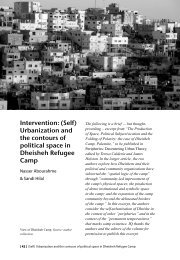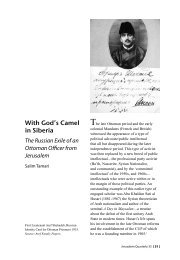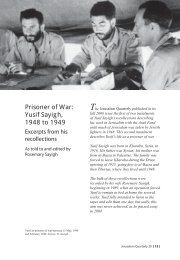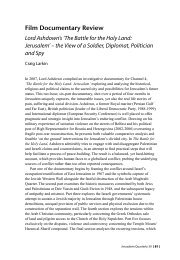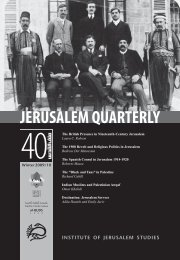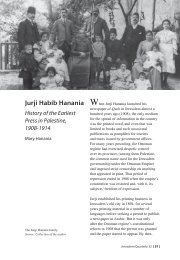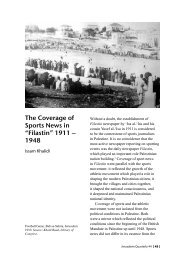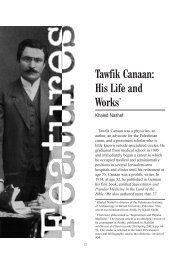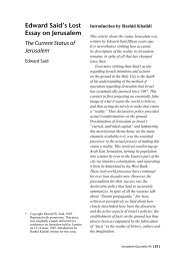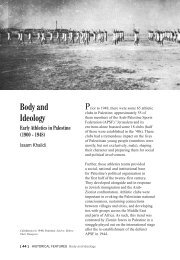PLUNDERING PALESTINE - Jerusalem Quarterly
PLUNDERING PALESTINE - Jerusalem Quarterly
PLUNDERING PALESTINE - Jerusalem Quarterly
You also want an ePaper? Increase the reach of your titles
YUMPU automatically turns print PDFs into web optimized ePapers that Google loves.
Khirbet Fa’ush: This Early Roman site will most probably be destroyed because it<br />
falls within the predicted route of the Wall.<br />
Aboud Under Threat<br />
In late December 2005, PACE conducted a survey in the area of Aboud, a village<br />
northwest of Ramallah, in order to document the potential impact the Wall will have<br />
on Aboud’s archaeological and cultural heritage. Based on the results of the survey<br />
there is legitimate concern that the projected path of the Wall in Aboud endangers the<br />
rich archaeological and cultural heritage of the area unless immediate action is taken.<br />
The Western Hills of Aboud<br />
The area west and north of Aboud, with its large assemblage of Roman temples, stonecut<br />
tombs, olive presses and caves will be endangered by the construction of the Wall.<br />
This is not only problematic from an economic perspective, as the whole area will be<br />
isolated from the village, but problematic from a cultural heritage perspective, too. This<br />
area constitutes the only ‘breathing space’ for the people of Aboud and has historically<br />
been the site of the village’s economic industrial activities (e.g. stone quarrying, lime<br />
production) and agricultural activities (e.g. vine cultivation, olive production, cereal<br />
grain cultivation, animal husbandry). From ancient times, the people of Aboud have<br />
utilized this area to support and maintain their economy. Agricultural areas threatened<br />
by the projected path of the Wall include: She’b al-Iraq, which the Israelis confiscated<br />
in order to construct a water tower for the settlements; She’b al-Bullat, and Khalat al-<br />
Qadat (‘the Resting Place’), which has a sizable olive grove belonging to Aboud known<br />
locally as Hareqat Nasser. The plain of Khalat al-Kadat, which has historically been used<br />
to cultivate wheat and other cereal grains, has been left uncultivated as a result of its<br />
isolation from the people of Aboud and proximity to the neighbouring Israeli settlement<br />
of Beit Arieh. It will now be completely cut off from the village for good. Agricultural<br />
sites such as these are important aspects of traditional Palestinian agrarian culture and<br />
should not be underestimated in a discussion of endangered cultural heritage.<br />
Tell el-Bullat<br />
Located to the southwest of the village of the same name, Tell el-Bullat has numerous<br />
stone-cut, plaster-coated wells. The major well at the tell is called ‘al-Assad’ (‘Lion’s<br />
Well’), which, according to local tradition, was frequented by lions during antiquity.<br />
In addition, Tell el-Bullat has several latuns (kilns used for the production of lime<br />
from local limestone), which were once used to produce the main material used in<br />
construction. Nearby is the area known as al-Qadat, a narrow inner plain surrounded<br />
by hills used as a recreation area in history and today.<br />
<strong>Jerusalem</strong> <strong>Quarterly</strong> 33 [ 47 ]



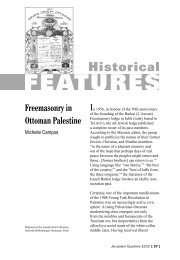
![In Search of Jerusalem Airport [pdf] - Jerusalem Quarterly](https://img.yumpu.com/49007736/1/180x260/in-search-of-jerusalem-airport-pdf-jerusalem-quarterly.jpg?quality=85)
